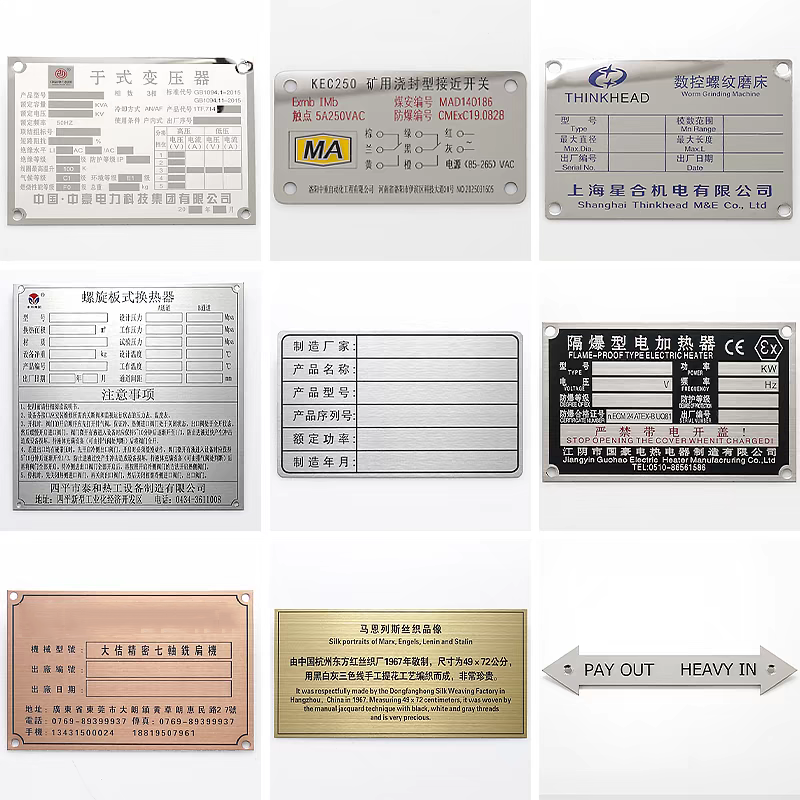In the complex and often hazardous world of industrial facilities—from oil refineries and chemical plants to power generation and water treatment centers—clarity and safety are paramount. Amidst the labyrinth of pipes, vessels, and equipment, one of the most humble yet critical components for maintaining order and safety is the valve identification tag. These small, durable labels are the unsung heroes of plant operations, providing essential information at a glance. Without them, routine maintenance, emergency shutdowns, and daily operations would be fraught with risk and inefficiency.
This article dives deep into the five critical aspects of valve identification tags that every engineer, operator, and safety manager needs to understand to ensure a safe, compliant, and efficient working environment.

At its core, a valve identification tag serves as a permanent, on-the-spot data source. Its primary purpose is to provide unambiguous identification for every valve in a system. Imagine a fire breaks out near a bank of pipes. An operator needs to quickly isolate a section to prevent escalation. Without a clear tag, they waste precious seconds—or minutes—trying to locate the correct valve, potentially with catastrophic consequences.
The key purposes include:
Safety: Enables quick and correct valve operation during emergencies, lockout/tagout (LOTO) procedures, and routine maintenance, preventing accidental releases of hazardous materials or energy.
Efficiency: Drastically reduces the time needed for personnel to locate specific valves for operation, inspection, or repair, boosting overall productivity.
Regulatory Compliance: Meets the requirements of standards like OSHA (Occupational Safety and Health Administration) and ANSI/ASME A13.1, which mandate the identification of piping systems and their components.
Knowledge Preservation: Acts as a permanent record, crucial for training new employees and ensuring operational continuity despite staff turnover. The information on a valve identification tag is a vital piece of the facility's institutional memory.
Decoding the Information: What's on a Standard Valve Identification Tag?
A valve identification tag is more than just a number. It's a carefully designed data plate that conveys specific information in a standardized format. While the exact content can vary by company and application, a comprehensive tag typically includes:
Unique Valve Number: This is the primary identifier, often tied to a Piping & Instrumentation Diagram (P&ID) or a Computerized Maintenance Management System (CMMS). This number allows personnel to cross-reference the physical valve with its technical documentation.
Service Description: A clear, concise description of the fluid or media the valve controls (e.g., "CRUDE OIL INLET," "COOLING WATER RETURN," "PLANT AIR").
System Pressure and Temperature: Critical data for personnel performing maintenance, ensuring they are aware of the system's operating conditions.
Piping Specification or Line Number: This links the valve to the specific pipeline it is part of, as defined in the plant's engineering drawings.
Plant/Area Designation: In a large facility, this specifies the unit or area where the valve is located (e.g., "UNIT 4," "BOILER HOUSE").
Safety Warnings (if applicable): Icons or text indicating hazards such as high temperature, high pressure, or electrical danger.
The consistency in the information presented on every valve identification tag is what creates a reliable and universally understood system.
Material Matters: Choosing the Right Valve Tag for Your Environment
Not all valve identification tags are created equal. Their ability to survive and remain legible in their operating environment is what makes them effective. Selecting the right material is a critical decision. Common options include:
Metallic Tags: Made from materials like aluminum, stainless steel, or brass. These are ideal for high-temperature environments, outdoor exposure, and areas with significant physical abuse or chemical splash. They can be stamped, etched, or engraved for permanent marking.
Plastic Tags: Constructed from durable plastics like PVC, Polyester, or Vinyl. These are cost-effective, resistant to a wide range of chemicals and moisture, and suitable for indoor or mildly corrosive environments. They are often printed with thermal transfer printers for high-resolution text and graphics.
Specialty Materials: For extreme conditions, such as high-corrosion areas (e.g., offshore platforms) or cryogenic applications, specialized plastics or coated metals are used to ensure the valve identification tag does not degrade or become unreadable.
The choice of material directly impacts the longevity, legibility, and overall return on investment of your valve tagging program.

The Installation and Placement Guide: Ensuring Tags Are Seen and Understood
A perfectly designed valve identification tag is useless if it's installed in the wrong place. Proper placement is governed by a simple principle: maximum visibility and accessibility. Key guidelines include:
Consistent Location: Standardize the tag's position relative to the valve. A common practice is to place it on the pipe, just before the valve inlet, or on the valve body itself if space allows. The goal is for an operator to always know where to look.
Clear Line of Sight: The tag must be easily visible from the normal operator access point, not hidden behind other pipes or insulation.
Secure Attachment: Tags must be affixed with materials that can withstand the environment. This includes stainless steel wires, nylon zip ties, or industrial-grade adhesives. The attachment method must be as durable as the tag itself to prevent it from falling off.
Avoiding Obstructions: Ensure the tag does not interfere with the valve's operation or any moving parts.
A well-executed installation strategy ensures that the critical information on the valve identification tag is immediately available when needed most.

Best Practices for a Successful Valve Tagging System
Implementing or auditing a valve tagging program goes beyond just buying tags. It requires a strategic approach to be truly effective.
Develop a Standard: Create a comprehensive written standard that details everything: the naming convention, the information hierarchy on the tag, the material specifications for different areas, and the rules for placement. This document ensures consistency for years to come.
Integrate with Documentation: The unique identifier on the valve identification tag must seamlessly link to your P&IDs, isometric drawings, and maintenance software (CMMS). This integration creates a powerful digital twin of your physical assets.
Regular Audits and Maintenance: Valve tagging systems are not "set and forget." Schedule regular audits to check for missing, damaged, or faded tags. Replace them promptly to maintain system integrity.
Train Your Personnel: Every employee who interacts with valves must be trained to understand the tagging system. They should know how to read a tag, what the information means, and why it's critical to never remove or obscure one.
By adhering to these best practices, a company can transform a simple tagging program into a cornerstone of its operational excellence and safety culture. The humble valve identification tag becomes a key node in a connected, intelligent, and safe industrial facility.
Frequently Asked Questions About Valve Identification Tags
Q1: What is the difference between a valve tag and a pipe marker?
A1: A pipe marker is a label placed along the length of a pipe to identify the material flowing inside it (e.g., "Steam," "Chilled Water") and often includes flow direction arrows. A valve identification tag is specifically attached to a valve and provides detailed, unique information about that specific component, such as its unique ID number, system pressure, and its link to engineering drawings. They are complementary systems.
Q2: Are there specific color codes for valve identification tags?
A2: While there is no universal, single standard for valve tag colors, they are often aligned with the ANSI/ASME A13.1 standard for pipe marking. This means the tag's background color might correspond to the content of the pipe (e.g., yellow for flammable fluids, red for fire-quenching materials). However, many companies develop their own internal color-coding system for different areas, systems, or types of valves to enhance visual management.
Q3: What information is absolutely mandatory on a valve tag?
A3: At a minimum, a valve identification tag must have a unique identifier (valve number) and a clear service description (what the valve controls). Without these two pieces of information, the tag fails in its primary purpose of providing quick and unambiguous identification.
Q4: How often should we audit and replace our valve tags?
A4: It's recommended to include valve tags in your regular plant safety and integrity walkdowns. A formal audit should be conducted at least annually. Tags should be replaced immediately whenever they are found to be damaged, faded, illegible, or if the valve's service has changed.
Q5: Can valve tags be used for lockout/tagout (LOTO) procedures?
A5: No, standard valve identification tags are not a substitute for official LOTO tags and locks. LOTO procedures require dedicated, durable safety tags that are attached to an energy-isolating device to prevent the release of hazardous energy during maintenance. Valve identification tags are for identification purposes only, though they are crucial for identifying the correct valve to apply the LOTO device to.







